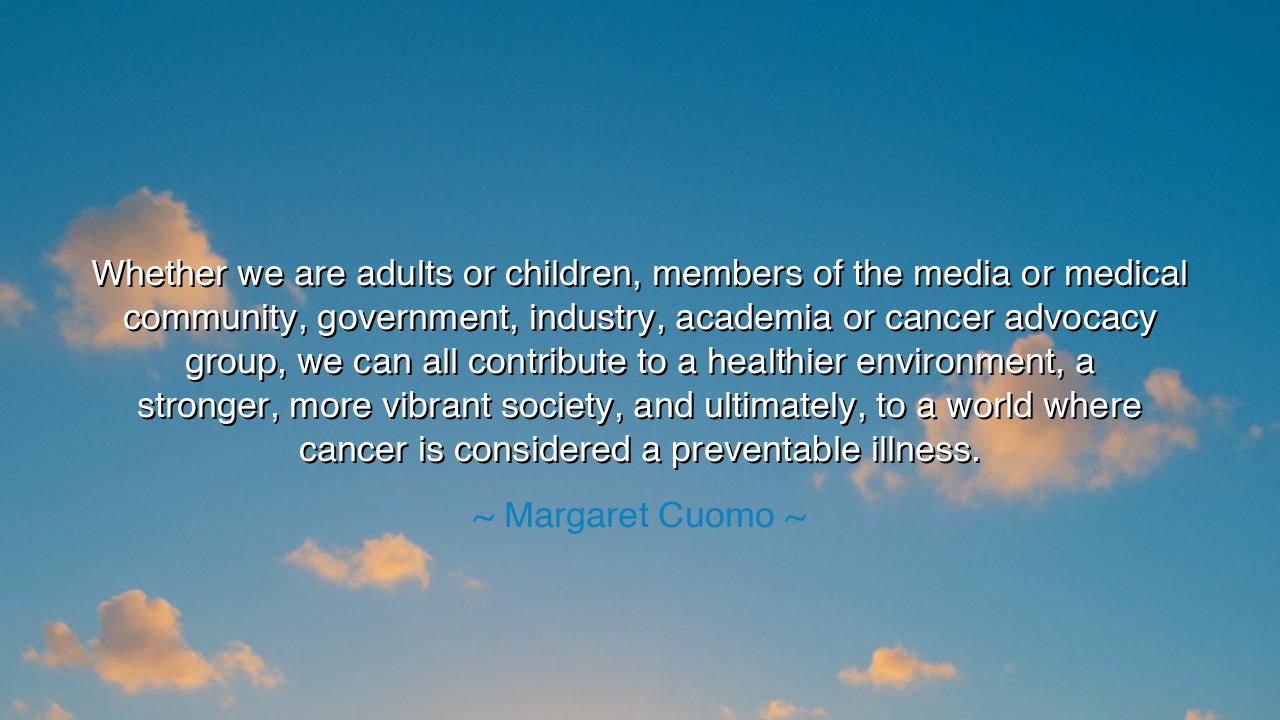
Whether we are adults or children, members of the media or
Whether we are adults or children, members of the media or medical community, government, industry, academia or cancer advocacy group, we can all contribute to a healthier environment, a stronger, more vibrant society, and ultimately, to a world where cancer is considered a preventable illness.






The words of Margaret Cuomo—“Whether we are adults or children, members of the media or medical community, government, industry, academia or cancer advocacy group, we can all contribute to a healthier environment, a stronger, more vibrant society, and ultimately, to a world where cancer is considered a preventable illness.”—stand as both an invitation and a challenge. They are a call to the conscience of humankind, reminding us that health is not the task of a few, but the sacred responsibility of all. In these words, Cuomo reawakens an ancient idea long forgotten in modern life: that the harmony of the body, the balance of society, and the purity of the world around us are bound together by the same thread of destiny. To protect one is to protect all.
At its heart, her quote speaks of unity in purpose—the idea that healing must transcend the walls of hospitals and the boundaries of professions. For too long, we have believed that disease belongs only to doctors, that prevention is the concern of scientists alone. Cuomo reminds us that this is an illusion. Every act, from the policies crafted in government halls to the stories told by the media, from the lessons taught in schools to the products made by industry, has a hand in shaping the health of our world. Cancer, in her view, is not merely a personal tragedy—it is a reflection of how we live as a collective, how we nourish or neglect the earth, and how we value the sanctity of life itself.
The origin of this wisdom lies in the convergence of science and morality. As a physician and advocate, Margaret Cuomo saw the devastation of cancer not only as a clinical reality but as a cultural one—born from polluted environments, unhealthy habits, and systemic inattention. Her call for collaboration echoes the philosophy of ancient civilizations, where medicine was not separate from ethics or environment. In the time of Hippocrates, healers taught that to keep the body well, one must also honor the balance of air, water, and earth. The ancients knew that the health of a person could not be separated from the health of their world. Cuomo’s words carry this same truth forward into our age of concrete and technology.
Consider, too, the example of Rachel Carson, whose book Silent Spring awakened the world to the dangers of toxic chemicals in the 20th century. She was not a doctor, nor a legislator, but a writer—a voice of warning who showed how one person, armed with knowledge and courage, could shift the course of public health. Her work led to the banning of DDT, the birth of the environmental movement, and countless lives saved from cancer and other illnesses caused by pollution. Cuomo’s call mirrors Carson’s legacy: that the power to heal does not belong only to those in white coats, but to all who dare to act with conscience and clarity.
Her message is also deeply spiritual. When she speaks of a “healthier environment and a more vibrant society,” she is not only referring to the absence of disease, but to the presence of harmony—between humanity and nature, between wealth and wisdom, between progress and preservation. She envisions a world where children grow beneath clean skies, where governments value prevention over profit, where industries innovate with respect for the living earth, and where every citizen feels responsible for the unseen chain that links their choices to the health of generations yet unborn.
There is a profound humility in her vision, for it acknowledges that even the smallest act matters. A child who learns to plant a tree, a teacher who introduces lessons on nutrition, a journalist who writes truth about toxins, a policymaker who funds prevention—all are healers in their own right. In the ancient temples of medicine, there was a saying: “The physician begins where the people end.” It meant that true health begins not in the hands of the healer, but in the hearts of the people themselves. Cuomo’s wisdom revives this teaching for our modern age—that the cure for disease must begin with the collective awakening of society.
The lesson we draw from Margaret Cuomo’s words is clear: the fight against cancer is not fought in isolation, but through unity, knowledge, and moral courage. Every citizen is a guardian of health. Every decision, no matter how small, ripples through the fabric of the world. Let us therefore act as stewards—of our bodies, our communities, and our planet. Let us choose clean food, clean air, and clean conscience. Let us teach our children that prevention is power, and that care for the earth is care for ourselves. For when humanity stands together in awareness and compassion, even the darkest illness can be turned back by the light of collective will.
And so, in the spirit of ancient wisdom reborn, may we carry forward Cuomo’s vision: to create not only a world where cancer can be prevented, but a world that remembers what it means to live in balance with life itself. For when the earth is healthy, and the people are united, the body of civilization itself will thrive—and in that harmony, both healer and healed shall become one.






AAdministratorAdministrator
Welcome, honored guests. Please leave a comment, we will respond soon